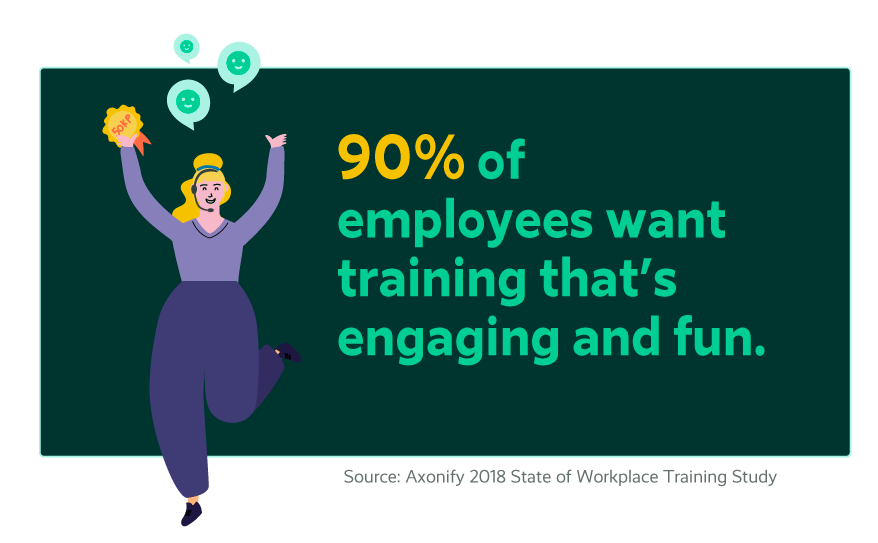Pros and Cons of Using Gamification with Your Customer Service Team
Lately, it seems companies are increasingly focused on the happiness of their employees. It’s with good reason — fulfilled and engaged employees are more likely to stay and be productive. It’s a win-win for the company and the staff.
Yet, a 2020 Gallup poll showed that just 36% of employees reported they were engaged with their job, on par with 2019’s survey (35%).
Worse, another 14% said they were “actively disengaged” with their job. These respondents “have miserable work experiences and spread their unhappiness to their colleagues” — something you definitely don’t want for your contact center team.
It’s clear that it is becoming increasingly difficult to retain employees. And with Millennials and Gen Z now a substantial part of the workforce, managers must learn to work with a variety of age ranges. Millennials, and Gen Z even more so, have grown up in an education system built around instant gratification.
Let’s be honest: As a Millennial myself, I received awards for holding the door open for my classmates and shiny medals just for passing the sixth grade. Not rocket science, yet I was still told I was special for doing so.
Other Millennials have grown up in a similar environment. They look for fast results, rewards, and quick growth. This is how we were raised.
As a manager, how do you gain control of your workforce and get your staff to bring in the results you need? Let’s look at the gamification pros and cons.
What Is Gamification in the Workplace?
Gamification is the concept of using game mechanics or game elements in a non-game context. This can mean badges, a point system, and moving up to the next level when employees perform well. It can even be as simple as creating leaderboards to showcase your highest-performing employees.
Pros of Gamification
There are many benefits to contact center gamification, but the number one reason companies adopt it is to engage and motivate employees.
Money was enough for Baby Boomers. It’s no longer the case for Millennials and Gen Z. In response, the corporate world has taken a page from the gaming industry, where users have motivators other than money.
When gaming, users aim for the top position or score. If used correctly, intrinsic motivation (personal motives) can be stronger than extrinsic motivation (external rewards such as money).
Gamification Can Reduce Training Time
Call center gamification has also been shown to improve training by increasing the amount of information employees retain and reducing the length of time it takes to do so simply by making training more fun.
Students would rather take part and role-play (or even watch their coworkers role-play) taking a complicated customer call rather than listen to a one-hour course on the subject.
Gamification has allowed companies to reduce their training time, thus saving money and getting new employees ready to start taking calls sooner.
Related Article: 4 Die-Hard Call Center Coaching Tips to Hold Everyone Accountable
Gamification Increases Productivity
Nobody likes to be bored at work, and 90% of employees say it’s important for their workplace training to be fun and engaging. By making the workplace more fun, it can also become more productive. When employees have strong intrinsic motivators, work doesn’t feel like work anymore, and they can look forward to their job.
Related Article: Why You Should Allow Your Call Center Agents to Socialize More
Gamification also boosts productivity by making the workplace more competitive. It provides an easy way to acknowledge and reward top performers. (But be careful — there’s such a thing as too much competition, as you’ll read below.)
Recognizing top performers plays a crucial role in employee satisfaction as it makes staff feel valued, thus further increasing their motivation to succeed in the workplace.
Related Article: How Gamification Can Help Call Centers Operate More Efficiently

Cons of Gamification
Gamification isn’t the answer to a poorly run call center. It won’t fix management issues, inadequate hires, or poorly trained staff.
Gamification is a tool to be used as an enhancer. It has to be done correctly and must be backed up by good management practices. Just as there are pros of gamification, there are also cons.
Gamifying Unnecessary Tasks
Call center gamification needs to be well-thought-out. Avoid creating a point system for a task that’s not getting done because employees find it tedious. Some work-related tasks are inherently boring, even when you dress them up with points, badges, and leaderboards. Filing documents won’t get done more often just because employees now receive a badge for doing so.
Forced Play
Games should be optional and not mandatory. They stop being fun when they become an obligation. Employees should have the option to participate (or not), and other forms of learning and growing should be available. The team at Disney learned this the hard way when gamification for their laundry staff was so harsh it earned them negative press.
Related Article: 9 Crucial Motivation Factors For Employees That Will Drive Staff Engagement
Not all staff learn the same way. Some prefer hands-on learning, job shadowing, or even reading material. Make other methods of learning available for your employees and let them choose.
Firing, Cheating, and Getting Ahead
Leaderboards can be a delicate topic. It can quickly become a “survival of the fittest” competition with the wrong company culture.
It can highlight the weakest employees just as much as it can the best. Therefore, you must set clear guidelines for how management takes action to avoid employee demotivation. Rewarding and training should be key, not scolding and firing.
Related Article: Essential Elements of an Effective Coaching Session for Your Employees
It can create tension between staff and management — and among employees. What starts as friendly competition can turn into employees cheating the system to score more points. In a workplace where employees turn on one another to get ahead, nobody wins. Cooperation and communication are essential to a thriving gamified workplace. Having the opposite effect of what you intended (engagement and motivation) is one of the biggest cons of gamification.
Gaming Loses Its Purpose
Setting up and maintaining a game-like system can be challenging. The novelty can wear off, and employees stop using it. Or the system is not set up correctly, and staff loses sight of the real end goal, affecting productivity negatively. After all, gamification is to help employees to stay on track, not play around mindlessly.
Gamification can do a lot to retain, train and motivate employees. The key is to have a comprehensive action plan for adopting it in your organization. Have you implemented games in your contact center? How has it improved productivity, motivation, or engagement for your agents? Tell us in the comments!
You can also keep agent quality up by staying on top of your contact center QA game with our eBook, The 2021 QA Success Blueprint: Improve & Monitor Your Call Center Agents.







